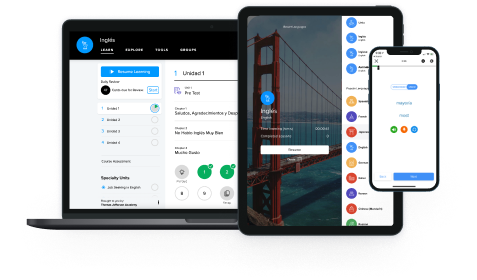Unlike other languages like English, German does not progressive verbs like “to be verbing” in English. In German, you’ll use words like gerade(at the moment) or jetzt(now) to express that something is happening in the moment rather than just happening in general.
Das Mädchen isst gerade ein Stück Kuchen.
The girl is eating a piece of cake.
lit. The girl eats a piece of cake at the moment now.
Ihr Bruder trinkt jetzt eine Tasse heißen Kakao.
Her brother is drinking a cup of hot cocoa.
lit. Her brother drinks a cup of hot cocoa right now.
Additionally, some regional varieties of German have their own ways to express progressivity. We will be looking at all of this in detail in this article. Let‘s get started!
What is the progressive aspect and how do you use it in German?
The progressive aspect is used to express that an action is, was, or will be actively in progress at a particular moment.
In English, we tend to express the progressive aspect with a special verb form: to be + verb-ing, as in “I am eating.” In German, though, there aren’t any special verb forms for the progressive, so you’ll need to indicate the difference between “I eat” and “I am eating” using other strategies.
The German equivalent of the English “-ing” form, the present participle (Partizip I) is never used to form continuous tenses!
I am eating (now).
lit. I eat now
To learn about when you should use this form, check out our post on the German present participle.
In order to make it clear that the action is taking place at this very moment, German has a variety of options in its pockets to emphasize that. Let’s have a look!
Using ‘gerade’ (at the moment) or ‘jetzt’ (now) to express progressivity
The most common way to express progressivity in German is to add the gerade, which translates to “at the moment” or “right now.” In regular main clauses, it’s always positioned after the verb and object.
adverbverb
Kannst du mich später anrufen? Ich lerne gerade für meine Prüfung.
Can you call me later? I am studying for my test at the moment.
Jetzt(now) can also be used to say that something is happening at the moment. However, jetzt is not used to express progressivity as often as gerade. The position is the same as above.
adverbverb
Ich habe wirklich keine Zeit. Ich konzentriere mich jetzt auf mein Buch!
I really don’t have time. I am focusing on my book now!
You can use both adverbs together — gerade jetzt or jetzt gerade. This is used when trying to stress the “in the moment” even more.
adverbverb
Gerade jetzt / Jetzt gerade beende ich das Kapitel. Ich rufe dich gleich zurück.
I am finishing up the chapter right now. I’ll call you back shortly.
Using ‘am’, ‘beim’, and ‘dabei’ to express progressivity
In German, you can sometimes use a like am, beim, or dabei before an infinitive verb to express progressivity. This option is considered to be more colloquial and more accepted in spoken than in written German. Though it originates in the Rhine dialect, it’s become more widespread over the years and can now be heard all over the German speaking world. Here is how to use these prepositions:
am and beim follow the pattern below:
infinitive verb
nominalized
Peter hat keine Zeit. Er ist am / beim Arbeiten.
Peter doesn’t have time. He is (in the middle of) working.
In this context, am and beim are completely interchangeable. The closest translation to English would be “to be in the middle of doing something.”
Notice that the infinitive verb you use here is technically a nominalized verb. This means that its first letter should always be capitalized.
✅Er ist am/beim Arbeiten.
❌Er ist am/beim arbeiten.
It also means that when the infinitive verb has an “object,” that object surfaces in German in the genitive case:
nominalized infinitivegenitive case
Timo ist am/bien Putzen seines Zimmers.
Timo is (in the middle of) cleaning his room.
lit. Timo is at (the) cleaning of his room.
dabei follows a related, but slightly different pattern:
Peter hat keine Zeit. Er ist dabei zu arbeiten.
Peter doesn’t have time. He is (in the middle of) working.
Timo ist dabei sein Zimmer zu putzen.
Timo is (in the middle of) cleaning his room.
Notice that the meaning and structure are very similar, but because the infinitive is a zu-infinitive instead of a nominalized verb, it can have a true object in the accusative case: sein Zimmer (his room).
If you want to spice it up a little and put more emphasis on the “now,” you can still add gerade(at the moment), jetzt(now) or a combination of both in those sentences.
seinadverbam/beimnominalized infinitive
Peter hat keine Zeit. Er ist gerade am Arbeiten.
Peter doesn’t have time. He is currently working (in the middle of) working.
Timo ist jetzt beim Putzen seines Zimmers.
Timo is cleaning his room right now.
Expressing progressivity using ‘immer noch’ (still)
If you want to express that someone is still doing something, you can say this by adding the phrases noch, immer noch, or noch immer. All three translate to the English “still” and are completely interchangeable. They are placed in last position in a sentence.
Paul hat noch keine Zeit. Er arbeitet noch/immer noch/noch immer.
Paul doesn’t have time yet. He is still working.
Timo putzt noch/immer noch/noch immer seinen Schreibtisch.
Timo is still cleaning his desk.
Expressing progressivity using ‘tun’ (to do) as an auxiliary verb
In Southern Germany (especially Bavaria) and the Austrian region, you can also utilize the verb tun(to do) + infinitive of the verb to express progressivity. This way tun basically functions as an to create the progressive aspect.
auxiliary verbinfinitive
Peter hat keine Zeit. Er tut arbeiten.
Peter doesn’t have time. He is (currently) working.
Timo tut sein Zimmer putzen.
Timo is cleaning his room.
Just like when you use other conjugated auxiliary verbs in German, tun comes in second position while the infinitive of the verb comes last. This is not a nominalized infinitive, so if the sentence has a direct object, the object is in the accusative case, as expected.
This construction, tun(to do) + infinitive, is only used in spoken German and often considered to sound “less educated” and to not be proper German! It is good to recognize it when you hear it, but we would recommend you learn other ways to express progressivity first!

